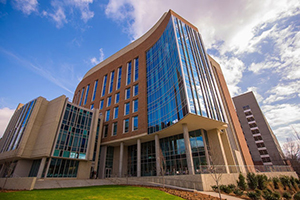The Engineering and Science Building has been awarded gold LEED status by the U.S. Green Building Council.
LEED or Leadership in Energy and Environmental Design, status is the rating system used to rank buildings of all types as certified, silver, gold or platinum based on the building’s environmental and cost-saving green features.

“Receiving gold status shows we are on the right path when we carry out building and renovating on campus,” said Mike Perez, associate vice chancellor of administration for facilities. “Making sure we are approaching these projects with long-term sustainability in mind has been a significant shift since the launch of FutureVU.”
The building includes laboratories, classrooms and a state-of-the-art cleanroom that houses both faculty and student learning and innovation. Its lighting saves energy through LED bulbs as well as occupancy sensors allowing lights to be off except where people are working.
“The Engineering and Science Building is a game-changer for our research enterprise. Its systems enable us to conduct more sensitive experiments,” said Philippe M. Fauchet, Bruce and Bridgitt Evans Dean of Engineering. “Adding the LEED Gold distinction just reaffirms our commitment to energy efficiency and sustainable building practices.”
“Our goal was to be very thoughtful in the materials used and how we could make sure this building lasts for generations of scholars,” said Keith Loiseau, university architect. “Balancing the tremendous energy needs of the building’s features with our university’s goals of responsible environmental design was the biggest challenge we faced.”
The Engineering and Science Building houses the university’s most energy efficient lab space. During the initial design phase of the building, 3D modeling was used to evaluate conditions of the site such as orientation, heat gain from windows, natural light, and others to ensure optimized design. Other green design elements that helped achieve its LEED status include:
- 20’ tall enthalpy wheels to transfer heat and humidity, conditioning the fresh air intake with exhaust air leaving the building
- Chilled beams supplied by hot and cold water used to condition spaces which is more efficient than conditioning with air systems
- A 10,000 gallon cistern to capture rain water for irrigation
- Sunshading frit on glass to optimize natural solar light and to also help prevent bird strikes
- Flexibility of design to allow different lab type use over time as well as lab renovations without major mechanical systems rework
- Cleanroom energy reduction through occupancy and particle sensors to decrease system use when not needed
For more information on building projects on campus, visit the Campus Planning and Construction website.